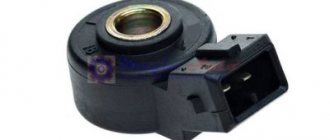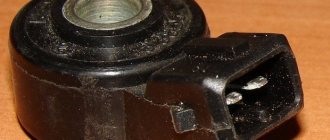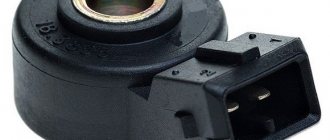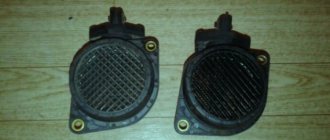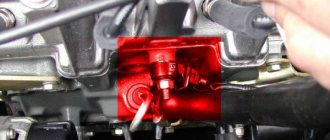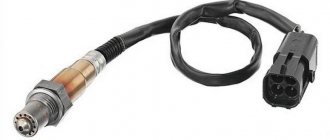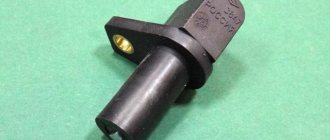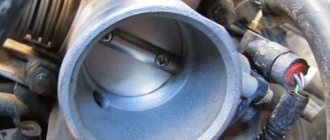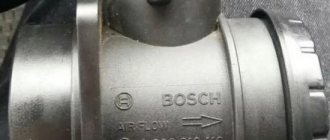The knock sensor is an important part of the car. The normal operation of the car engine depends on its functionality. Therefore, if a malfunction occurs, the owner needs to know where the knock sensor is located on the VAZ 2114 and be able to diagnose it. This article describes the location and purpose of the part, presents its main faults and their symptoms, as well as diagnostic methods.
How does a knock sensor work?
Car engines can use one of two types of knock sensors: resonant and broadband. But since the first type is already outdated and is rare, we will describe the operation of broadband sensors (WS).
The design of a broadband DD is based on a piezoelectric element, which, when subjected to mechanical action (that is, during an explosion, which, in essence, is detonation), supplies a current with a certain voltage to the electronic control unit. The sensor is configured to perceive sound waves in the range from 6 Hz to 15 kHz. The design of the sensor also includes a weighting agent, which enhances the mechanical effect on it by increasing the force, that is, it increases the sound amplitude.
The voltage supplied by the sensor to the ECU through the connector terminals is processed electronically and then a conclusion is made whether there is detonation in the engine, and accordingly, whether the ignition timing needs to be adjusted, which will help eliminate it. That is, the sensor in this case is only a “microphone”.
How is it diagnosed?
The operating principle of injection engines is practically the same for all cars. The control unit, which receives information from several controllers, is responsible for the balanced interaction of the components and assemblies of the motor. The knock sensor is one of them, and if it breaks, the engine runs intermittently. For example, let’s look at the method for determining error p0327 on the VAZ Priora ECU. To do this you need:
- warm up the engine to a temperature of 60 °C;
- set the crankshaft speed to 1300 rpm.
Next, you will need to connect the adapter cable to the diagnostic connector and take readings. In this case, the car must do at least 2 drive cycles in advance.
Signs of a malfunctioning knock sensor
If the DD fails completely or partially, a malfunction of the knock sensor manifests itself according to one of the symptoms:
- Engine shaking . If the sensor and control system in the engine are working properly, this phenomenon should not occur. By ear, the appearance of detonation can be indirectly determined by the metallic sound emanating from a running engine (knock of fingers). And excessive shaking and jerking during engine operation is the first way to determine a malfunction of the knock sensor.
- Reduced power or “dullness” of the engine, which is manifested by deterioration of acceleration or excessive increase in speed at low speeds. This happens when, with an incorrect DD signal, the ignition angle is spontaneously adjusted.
- Difficulty starting the engine , especially “cold”, that is, at low temperatures after a long period of inactivity (for example, in the morning). Although it is quite possible for the car to behave this way even at warm ambient temperatures.
- Increased fuel consumption . Since the ignition angle is disturbed, the air-fuel mixture does not meet optimal parameters. Accordingly, a situation arises when the engine consumes more gasoline than it needs.
- Fixing knock sensor errors. Usually the reasons for their appearance are the signal from the sensor going beyond the permissible limits, a break in its wiring, or a complete failure of the sensor. The occurrence of errors will be indicated by the Check Engine light on the dashboard.
However, it is worth considering that such symptoms may indicate other engine failures, including other sensors. It is recommended to additionally read the ECU memory for errors that could arise due to incorrect operation of individual sensors.
Knock Sensor Circuit Malfunctions
In order to identify DD faults more accurately, it is advisable to use electronic error scanners for the electronic control unit. Especially if the check indicator light on the dashboard lights up.
Often, error p0325 “Open in the knock sensor circuit” indicates problems in the wiring. This could be a broken wire or, more often, oxidized contacts. It is necessary to perform preventative maintenance on the connectors on the sensor. Sometimes error p0325 occurs because the timing belt slips by 1-2 teeth.
Error P0328 “Knock Sensor High” often indicates a problem with high-voltage wires. In particular, if the insulation on them or the piezoelectric element breaks through. Similarly, this error can also occur due to the fact that the timing belt has jumped a couple of teeth. To diagnose, you need to check the marks on it and the condition of the washers.
Errors p0327 or p0326 are usually formed in the ECU memory due to a low signal from the knock sensor. The reason may be poor contact from it, or weak mechanical contact of the sensor with the cylinder block. To eliminate the error, you can try treating both the mentioned contacts and the sensor itself with WD-40. It is also important to check the sensor mounting torque, as this parameter is critical to its operation.
In general, it can be noted that the symptoms of a malfunction of the knock sensor are very similar to the symptoms characteristic of late ignition because the ECU, for the sake of safety for the engine, tries to automatically do it as late as possible, since this prevents destruction of the engine (if the angle is too early, then in addition detonation occurs, not only does the power drop, but there is also a risk of valve burnout). So, in general, we can conclude that the main symptoms are exactly the same as with incorrect setting of the ignition timing.
Causes of knock sensor malfunction
As for the reasons why problems arise with the knock sensor, these include the following breakdowns:
- Loss of mechanical contact between the sensor housing and the engine block . As practice shows, this is the most common reason. Typically, the sensor itself has a round shape with a mounting hole in the middle, through which it is attached to its seat using a bolt or pin. Accordingly, if the tightening torque in a threaded connection decreases (the pressing of the motor to the engine is weakened), then subsequently the sensor does not receive sound mechanical vibrations from the cylinder block. In order to eliminate such a breakdown, it is enough to tighten the mentioned threaded connection, or replace the mounting bolt with a mounting pin, since it is more reliable and provides a tight mechanical connection.
- Sensor wiring problems . In this case, there may be various problems, for example, a short circuit of the supply or signal wire to ground, mechanical damage to the wire (especially in places where it is bent), damage to the internal or external insulation, breakage of the entire wire or its individual wires (supply, signal), violation of the shielding braid. In this case, the problem is solved by restoring or replacing its wiring.
- Poor contact at the connection point . This situation sometimes happens if, for example, the plastic latch at the point where the sensor contacts are connected is broken. Sometimes, as a result of shaking, the contact is simply broken, and accordingly, the signal from the sensor or the power to it simply does not reach the recipient. To repair, you can try replacing the chip, correcting the contact, or using another mechanical method to try connecting two pads to the contacts.
- Complete sensor failure . The knock sensor itself is a fairly simple device, so there is nothing special to break there, and accordingly, it rarely fails, but it does happen. The sensor cannot be repaired, so in case of complete breakdown it is necessary to replace it with a new one.
- Problems with the electronic control unit . In the ECU, like any other electronic device, software failures can occur, which leads to incorrect perception of information from the DD, and accordingly, the unit makes incorrect decisions.
It is interesting that when a car owner contacts a car service center with complaints about the operation of the knock sensor, some unscrupulous repairmen immediately offer to replace it with a new one. Accordingly, take more money from the client. Instead, you can try tightening the torque on the sensor threaded mount and/or replacing the bolt with a stud. In many cases this helps.
What to do if the problem recurs
If you replaced the knock sensor and deregistered p0327 in the ECU, and the “Check engine” icon appears again, then the problem may be in the engine sensor itself. It needs to be checked. You will need a multimeter, which should be set to resistance measurement mode (ohmmeter). The minimum threshold value is 5 MΩ (operating alternating voltage: U= 0.5–3 V). If it shows below, then the sensor is defective. It is unprofitable to repair it, since a new one costs about 250 rubles.
Another reason: the DD is attached to the cylinder block with a bolt. But its crimping force is small, so the detonation signal is weak. Experts recommend using a pin instead of a bolt, and tightening the sensor with a nut. Then the risk of error p0327 is sharply reduced. In addition, you should make sure that the formation of a malfunction is not caused by: extraneous knocks, such as vibration of the pan protection or the clatter of hydraulic compensators, as well as poor-quality fuel or poor fastening of the engine to the cylinder block.
On a note. Experts recommend buying one of two brands of knock sensors. First original: AvtoVAZ number 21120–3855020–03–0. Second analogue: Bosch - 0 261 231 046.
What are the effects of knock sensor malfunctions?
Is it possible to drive with a faulty knock sensor? This question interests motorists who are encountering this problem for the first time. In general terms, the answer to this question can be formulated as follows: in the short term, you can use the car, but at the earliest possible opportunity, it is necessary to carry out appropriate diagnostics and fix the problem.
Indeed, according to the principle of operation of the ECU, when a malfunction of the fuel knock sensor occurs, a late ignition is automatically set to prevent damage to the piston group parts if real detonation occurs during combustion of the fuel mixture. As a result, fuel consumption rises and dynamics drop significantly, which will become especially noticeable as the speed increases.
What happens if you turn off the knock sensor completely?
Some car owners even try to disable the knock sensor because under normal operating conditions and refueling with good fuel it may seem unnecessary. However, it is not! Because detonation occurs not only due to poor fuel and problems with spark plugs, compression and misfires. Therefore, if you disable the knock sensor, the consequences may be as follows:
- rapid failure (breakdown) of the cylinder head gasket with all the ensuing consequences;
- accelerated wear of elements of the cylinder-piston group;
- cylinder head crack;
- burnout (full or partial) of one or more pistons;
- failure of the jumpers between the rings;
- connecting rod bend;
- burning of valve plates.
This is due to the fact that if this phenomenon occurs, the electronic control unit will not take measures to eliminate it. Therefore, in no case should you turn it off and install a jumper from the resistance, because this is fraught with expensive repairs.
What it is? Types, principle of operation
Before moving on to the analysis of the device itself, it is worth analyzing the process that it controls.
Detonation, expressed in the spontaneous combustion of the air-fuel mixture ahead of time, creates strong resistance to the piston stroke. Because of this, the power unit loses power, and fuel consumption increases noticeably. If a similar situation occurs on a small engine with a sufficient amount of horsepower and high torque, it usually appears at low speeds and disappears without a trace. Forced internal combustion engines can be seriously damaged by detonation that occurs at high speeds.
This phenomenon occurs for several reasons:
- using fuel with more octane than recommended;
- specific design of the power unit (compression force, location of spark plugs, combustion chamber lines, air supply, etc.);
- operating conditions of the engine (its operating condition, the value of the set advance angle, load level, etc.).
The knock sensor (DS) is a special control device that performs its functions in accordance with the piezoelectric effect. It is installed on modern gasoline engines between the 2nd and 3rd cylinders, just below the intake manifold and responds to noise in the range of 25-75 Hz. This allows him to make high-quality adjustments to the functioning of the cylinder head.
This arrangement allows you to be at an optimal distance from both cylinders, which will ensure that the hottest combustion chamber is fixed. This will be the point of detonation. The DD installation location itself must have a flat surface to avoid sound distortion or resistance. Reliable fixation is achieved by using a threaded pin.
It works on the following principle:
- the voltage created by mechanical impulses on the piezoelectric part increases as the oscillations increase;
- at the moment the voltage exceeds the safe threshold, the DD sends a signal to change the value of the advance angle;
- the device constantly converts mechanical pressure into an electrical impulse, which is sent to the control unit (this allows the system to timely optimize injection and ensure the required ignition timing);
- this makes the engine operate more efficiently and economically.
According to their type, DD are divided into:
- The most common broadband;
- Resonant.
Resonant ones react to changes in the frequency of micro-explosions in the combustion chamber. Externally, they resemble an oil pressure sensor with fasteners in the threaded fitting format. If there is a significant change in the frequency of micro-explosions, a signal is sent to the controller.
How to determine if a knock sensor is faulty
When the first signs of DD failure appear, a logical question is of interest - how to check and determine the malfunction of the knock sensor. First of all, it must be said that checking the knock sensor is possible without removing it from the cylinder block, or after removing it from its seat. Moreover, first it is better to do several tests when the sensor is screwed to the block. Briefly the procedure looks like this:
- set the idle speed to approximately 2000 rpm;
- With some metal object (small hammer, wrench), apply one or two gentle blows (!!!) to the cylinder block body in the immediate vicinity of the sensor (you can lightly hit the sensor directly);
- if the engine speed drops after this (this will be audible), it means the sensor is working;
- The speed remains at the same level - an additional check needs to be performed.
To check the knock sensor, a car enthusiast will need an electronic multimeter capable of measuring the value of electrical resistance, as well as DC voltage. The best way to check is with an oscilloscope. A diagram of the sensor operation taken with its help will clearly show whether it is operational or not.
But since only a tester is available to the average car enthusiast, it is enough to check the resistance readings given by the sensor when tapped. The range of resistance changes is within 400 ... 1000 Ohms. It is also imperative to carry out a basic check of the integrity of its wiring - whether there is a break, damage to the insulation or short circuit. You also cannot do this without the help of a multimeter.
If the check shows that the fuel knock sensor is working properly, but the error indicates that the sensor signal is outside the permissible range, then perhaps it is worth looking for the cause not in the sensor itself, but in the operation of the engine or gearbox. Why? Sounds and vibration are to blame for everything, which the engine can perceive as fuel detonation and incorrectly adjust the ignition angle!
Signs of a faulty knock sensor VAZ 2114
Signs of a malfunction of the VAZ 2110 knock sensor. Something always breaks in a VAZ. If the car owner knows the signs of a malfunction of the VAZ 2110 knock sensor (and, of course, other controllers) and knows how to read the errors shown by the ECU, this can make his life much easier. Not a single sensor is built into the car just like that; each one is designed by the designers to maintain and check the normal operation of various components.
From this point of view, the device that displays the level of detonation is particularly noteworthy. As long as the engine is running normally and no explosions occur, the engine can be said to be asleep. The car control system uses tabular, optimal parameters, giving instructions to the motor. However, if detonation occurs, the sensor instantly measures its strength, transmits the data to the on-board computer, and it reduces the advance angle. The correction occurs until the joint efforts of the motor control unit and the ECU stop the detonation, after which the sensor again seems to hide and fall asleep.
Thanks to such actions, all the troubles and dangers that arise from a detonating fuel-air mixture are prevented. And there are not so few of them, and they can sometimes cause significant damage to the engine unit in particular and the car as a whole. Signs of a malfunction of the VAZ 2110 knock sensor will help its owner understand what is happening with his car and take appropriate measures in a timely manner. About what visual points you should pay attention to, first of all, in order to detect a DD malfunction in time, and how to prevent it.
What you can notice first The knock sensor itself is quite reliable and does not fail very often. However, its performance should be checked in case of uncharacteristic behavior of the engine: a clear drop in engine power; “dullness” of the engine, increased speed at low speeds; deterioration of car acceleration; increased fuel consumption. It can reach +10%; smokier than usual exhaust. Tapping fingers and sudden jerks in movement may also be observed, but these are more individual reactions. Additional check Regarding electronic warnings.
Unfortunately, the control system often makes mistakes. So before trusting her information, it is worth conducting additional verification. Code 34 indicates failure of the DD. However, to make sure of this, you need to reset the self-diagnosis results, make a circle a couple of kilometers around the house and look at the readings again. If there is no error signal, it means that either the on-board computer was mistaken, or the sensor operates intermittently due to loose or oxidized contacts. Code 325 reports a broken DD. But often the unit records malfunctions of the throttle position sensor in its memory under these numbers. To check the assumption, you need to go into the menu and look at the voltage data on the suspected sensor: if the TPS is acting up, it will jump, while the detonation readings remain normal.
Searching for the cause As already mentioned, the DD is a surprisingly robust device. In most cases, it is enough to look for an open circuit, and first check the terminals. The wires ring if the self-diagnosis does not light up immediately, but when the engine spins above 3000 rpm. If the electrics are in order, the knock sensor itself is checked. It is located on the left in the direction of travel, where the air filter is located.
It is difficult to get to it, since the sensor is located between the cylinders - this allows it to take readings from the entire block. The sensor is dismantled. To do this, you will need a 13 socket key if your machine has a single-pin DD, and a 22 socket if it has a two-pin one.
Take a voltmeter with good sensitivity and set it to a mode of up to 200 MV. If there are 2 contacts, the sensor connectors are connected to the device. On another type of sensor, one probe is thrown onto the contact, the second – onto the body. Using a screwdriver, bolt or heavy pen, tap the body with varying strength (but without zeal). The voltmeter readings should fluctuate: the more noticeable the shock, the larger the jump.
If the device does not respond to influences, you need to change the sensor. Sometimes people try to save money on it by buying a used one, but this is not worth doing: a new one costs 200-300 rubles, which can be considered quite affordable, and a used one may be in even worse condition than a removed one. If all checks have been carried out and even the DD has been replaced, but signs of a malfunction of the VAZ 2110 knock sensor remain, then the problem is not at all with it.
Detonation is caused by other factors, among which the first place is gasoline poured in an untested place. However, other factors may also have an effect: compression problems, flooded or burnt-out spark plugs, etc. If you are confident in the integrity of the knock sensor, you will have to dig much deeper into the insides of the car.
Check and replacement
Even if the scanner showed a malfunction of the DD, it’s a good idea to make sure that the part is not working.
The knock sensor is checked using an ohmmeter by measuring the resistance or a digital voltmeter by measuring the voltage between the contacts. The resistance of a working sensor on VAZ car models is almost infinite, but if it is small or absent altogether, the sensor must be replaced.
The voltage is measured as follows:
- Set the measurement limit on the voltmeter to 200 millivolts;
- The probes of the device are connected to the sensor contacts;
- Gently tap the DD body with any medium-heavy object (screwdriver, pliers);
- At this moment they look at the voltmeter readings.
At the moment of impact, the voltage on the device increases by 20-40 mV, depending on the force of the impact. The stronger the blow, the greater the tension.
Replacing the knock sensor on a VAZ 2114 is very simple. If the DD is broadband, then you will need a combination key of 13; for a single-contact sensor you will need a key of 22. Do it as follows:
- We turn off the engine;
- Open the hood;
- We disconnect the connector plug on the wires going to the DD;
- We unscrew the 13 nut from the stud (in the 2-pin version) or the piezoelectric sensor itself with a 22 wrench (resonant DD);
- We put the new part in place and connect the plug.
That's it, very simple. You also need to take into account the tightening torque - the force is small, about 2 kgf/m². With greater force there is a risk of breaking the thread.
Where is the knock sensor on a VAZ 2114
I’ll start today’s article with a story about what a knock sensor (DS) is and why a car engine needs it. This sensor is necessary, as the name implies, in order to monitor detonation in the engine, as well as knocking noises that indicate malfunctions.
Each knock causes the sensor to produce a pulse with a certain voltage. After this, the pulse goes to the controller, which performs subsequent processing. The controller adjusts the ignition timing depending on the size of the received impulse; the whole process takes a few fractions of seconds, so most often we simply cannot feel anything.
DD belongs to that category of automotive sensors that fail very rarely, for which a HUGE driver’s THANK YOU to him and his creators!
Where is the knock sensor located?
The VAZ 2114-2115 knock sensor is located between the second and third cylinders on the engine block; it can be one- or two-contact.
Removal
Where is the VAZ 2114 knock sensor located in the car? The device is located inside the 8-valve engine, near the cylinders or intake manifold, which means it won't be easy to find. You may have to remove the top of the engine, also called the head, and start searching.
After the mechanism is found and dismantled, it must be cleaned. There are two ways to clean the connector: using alcohol as a cleaning agent or using a special cleaner. The device can be placed in a plastic bag and wiped with alcohol or cleaned with a cleaning agent. In both cases the result will be almost the same.
After cleaning, allow the mechanism to dry for half an hour before installing it back into the engine. You should also check for damage to the wiring.
To your attention errors in the knock sensor VAZ 2114
- Error code 0325 - there is a break in the wiring that supplies power to the DD. Most often, the cause of this error is oxidized contacts of the knock sensor; a wiring break occurs extremely rarely. It is necessary to clean the contacts, this will give a positive result, at least it will not get worse. In addition, this error can be caused by the timing belt, so if after cleaning the DD contacts the problem remains, check the timing belt, most likely it has jumped a couple of teeth. Align the belt to the marks and check again if the error appears.
- Error code 0328 - as a rule, indicates faulty high-voltage wires. However, the possibility of the timing belt jumping cannot be ruled out.
- Error code 0326 , as well as 0327 , mean an excessively weak (low) signal from the knock sensor. To eliminate errors, it is necessary to clean the VAZ 2114 DD connection contacts. The tightening torque of the sensor is also important; if the tightening is weak, the above errors may appear.
Additional comments for troubleshooting P0328
When diagnosing the P0328 code, it is very important to follow the diagnostic protocol to ensure all checks and repairs are performed correctly.
To make a proper diagnosis, a mechanic will need a professional scanner that can not only read stored error codes, but can also view data from various sensors, such as fuel pressure and engine coolant temperature, in real time.
Need help with error code P0328?
The company - CarChek, offers a service - on-site computer diagnostics; specialists from our company will come to your home or office to diagnose and identify problems with your car. Find out the cost and sign up for on-site computer diagnostics or contact a consultant by phone
Good afternoon everyone! I am the owner of a VAZ 2115, and for about a year it periodically gives me error P0328. Now the error began to appear every time the engine brakes.
What was done: 1. The valves were adjusted. 2. Replaced knock sensor. 3. Due to circumstances, the ECU was replaced, the old one died. 4. The grenades were replaced (because they crunched). 5. Cleaned the injectors. 6. The fuel pump has been checked (pressure is normal). 7. The timing belt has been replaced (marks are in place). 8. Armor wires have been replaced. 9. Spark plugs replaced. 10. The error appears on 92 and 95 Benz, as well as on G-Drive. 11. Engine mounts are normal. 12. The factory foil engine protection is screwed on well, does not rattle, does not ring, or touches anything. 13. It’s clean under the hood. 14. Computer diagnostics did not reveal any deviations in the sensor readings. 15. According to the on-board driver, the average consumption in the city is 12.5 l/100 km, the average speed is 13 km/h. The expense is high though. but in my opinion this is the norm, because... zama, traffic jams, warming up, short trips.
How to check the knock sensor of a VAZ 2114-2115
- Prepare the end face at “13” or “22” (depending on the type of sensor).
- Multimeter or voltmeter.
- Screwdriver.
Sequencing:
- Remove the sensor from the engine block.
- Turn on the voltmeter or multimeter in operating mode with a limit of 200 mV.
- Connect the multimeter electrodes to the knock sensor terminals, then use a screwdriver to tap the part body.
- While tapping, observe the changes on the device display; depending on the strength of the blows and frequency, the voltmeter readings should change. If your knock sensor readings do not change, it is faulty and needs to be replaced.
VAZ knock sensors come in two types:
- Resonant (made in the shape of a barrel).
- Broadband (made in tablet form).
These sensors are completely different, so before you buy a knock sensor for a VAZ 2114 or 2115, check which one you have installed.
Checking DD yourself
Knock sensor for VAZ 2110
The knock sensor is located between cylinders 2 and 3 on the radiator side directly on the engine block. Checking the knock sensor is a simple matter, especially if you have ever looked under the hood of the fourteenth.
Replacing the knock sensor VAZ 2114
- The key end is 13 for a single-pin DD (resonant) and 22 for a two-pin DD (broadband)
- Simple screwdriver
- Multimeter
How to check the knock sensor
The first thing to do is remove the DD. It’s easier to remove the single-pin one: don’t touch the ignition, turn it off and unscrew the sensor from the engine. The two-pin one is more complicated: we also don’t touch the ignition, but we also need to remove the negative from the battery. Then, remove the wires of the block, unscrew the DD fastening and remove it.
Second, we switched the multimeter to a voltmeter and set the limit to 200 MV. We connected it to the DD and carefully hit it with some piece of iron (the same screwdriver). When impacted, the voltage should jump; if there is no jump, the sensor is dead, go to the store for shopping.
When a two-pin DD is connected, its terminals cling to the multimeter, when a single-contact DD is connected, one contact and its body are clinging.
Third, we look at the wiring, as already mentioned, most often it’s a matter of frost, or broken contacts.
A simple plan on how to check the knock sensor in your garage with properly trained hands.
Opinions agree that a non-working DD should not be replaced with an analogue from the factory. You will buy a pig in a poke with a 1 in 10 chance that you will get a working one. For the fourteenth, DD from 406 engines for the Volga or a universal imported Bosch are perfect.
Why do you need a knock sensor on a VAZ 2114?
The operation of the VAZ 2114 power unit may be accompanied by the appearance of detonation. It has a bad effect on the engine, creating parasitic vibration and having a destructive effect on the main elements of the internal combustion engine.
Damage and metal fatigue gradually accumulate in the engine, which results in the imminent need for major engine repairs. A combination of electronic control units and DD is working to eliminate detonation. The meter detects the occurrence of non-optimal ignition of the fuel-air mixture, and the main module corrects the spark advance angle.
Purpose of the knock sensor
Early VAZ 2114 models used a resonant knock sensor. Subsequently it was replaced by broadband. Both DDs have a similar principle of operation, but differ significantly in design. Therefore, they are absolutely non-interchangeable.
The broadband DD is made in the shape of a round torus. It is attached to the engine with a bolt passing through a hole located in the center. There is a two-pin connector on the side of the torus for connection to the main module.
Fixing the resonant knock sensor does not require the use of a bolt. On one side of its body there is a thread with which it is screwed into a seat on the cylinder block.
A piezoelectric element is located inside both types of DD. It is sensitive to vibration and shock. The difference between the resonant DD is its narrower control range.
An electrical signal of a certain frequency and amplitude is generated inside the knock sensor. It goes to the ECU. The electronic control module monitors and analyzes the received signal. When detonation is detected, the ECU adjusts engine operation according to the established algorithm.
Eliminating detonation minimizes parasitic loads on the engine. As a result, the engine resource increases. This is what the knock sensor affects.
Device and purpose
The basis of the knock sensor (DS) is a piezoelectric element. When mechanically applied, an electrical impulse is generated on it, this impulse is sent to the engine control unit. The electronics detects the occurrence of detonation and, based on the data obtained, adjusts the ignition angle, thereby protecting the internal combustion engine (ICE) from mechanical damage.
To find out where the knock sensor is located on a VAZ 2114, you need to open the hood and look under the cylinder head between the second and third cylinders; it is installed on the internal combustion engine block (this can be seen in the figure above). On a 16-valve engine it will be more difficult to see right away; the cylinder head is more massive and blocks the view.
There are two types of DD:
- Resonant (single-contact),
- Broadband (two-contact) sensors.
The resonant knock sensor was installed on early releases of VAZ 2113, VAZ 2114 and VAZ 2115 cars (they are completely interchangeable). It is rarely found on sale lately, and the price of the part is quite high. A single-contact knock sensor works on the principle of capturing the detonation frequency, while a broadband (two-contact) sensor receives the entire noise band, and then detects detonation noise in it. These devices are not interchangeable, as they operate on different principles. Replacing the wiring does not solve the problem, so when remaking the system, you also have to change the electronic control unit (ECU).
But replacing the ECU is ultimately worth it, given the difference in price of the parts. A resonant DD from GM costs approximately 2,600 rubles. At the same time, the price of broadband DD is in the range of 230-320 rubles. If desired, a spare part can be found even cheaper, for example, a two-pin DD manufactured by StartVolt is sold at a price of 170-210 rubles. It makes sense to redo the entire system once rather than constantly have to worry about finding and replacing a single-contact knock sensor.
Location of the knock sensor on the VAZ 2114
The location where the DD is located is selected in such a way that the sensor has the greatest sensitivity. Therefore, the DD is mounted directly on the cylinder block. You can find the location by tracing the wires coming from the electronic engine control unit. It is easier to do this on a VAZ 2114 with an 8-valve engine, since its engine compartment layout is less loaded. On a car with 16 valves, it is more difficult to determine what each loop and sensor is responsible for.
Sensor cost
On VAZ 2114 cars of early production years there is a Lada sensor 21120385501001. It has an extremely low prevalence and because of this its price is high and amounts to 800-1300 rubles. The only commonly found analogue is General Motors 21120-3855010-01 with a cost of 1600-1800 rubles.
The original broadband DD has article number 21123855020. Its price is much lower and amounts to 100-160 rubles. Its good analogues are presented in the table.
Table - Good analogues of the original VAZ 2114 knock sensor
| Manufacturer | vendor code | Approximate cost, ruble |
| Fenox | SD10100O7 | 210-420 |
| Decaro | 2112-3855020 | 360-490 |
| Samara 2112 | 3855020 | 200-250 |
| Road map | 21123855020 | 260-380 |
| ERA | 550489 | 300-340 |
Methods for checking a knock sensor
If signs of malfunction of the DD appear, then you should check for errors. About problems with the knock sensor they say:
- code 0326, indicating the signal level is too high;
- code 0327, indicating a low signal level, for example, due to the fact that the tightening torque does not correspond to the nominal one;
- code 0325, there is an open circuit in the circuit
You can check the DD by measuring the resistance.
You can check the DD with a multimeter. To do this, check the presence of voltage at the sensor outputs when tapping it with a metal rod.
On which cars is this problem most common?
The problem with code P0328 can occur on different machines, but there are always statistics on which brands this error occurs more often. Here is a list of some of them:
- Audi (Audi a4)
- Chevrolet (Chevrolet Captiva)
- Hyundai (Hyundai Accent, Elantra)
- Infiniti (Infiniti fx35)
- Kia (Kia Sid, Cerato)
- Lexus
- Mazda (Mazda 2, Mazda 3, Mazda 6, Demio, Premasi)
- Nissan (Nissan Almera, Xterra, Murano, Teana, Frontier)
- Opel (Opel Astra)
- Skoda (Skoda Octavia)
- Subaru (Subaru Outback, Tribeca, Forester)
- Suzuki
- Toyota (Toyota Avensis, Camry, Rav4, Sienna)
- Volkswagen (Volkswagen Passat, Polo)
- VAZ 2109, 2110, 2112, 2114, 2115
- Lada Kalina, Niva, Priora
With fault code P0328, you can sometimes encounter other errors. The most common ones are: P0132, P0152, P0158, P0171, P0183, P0324, P0325, P0326, P0327, P0329, P0330, P0331, P0332, P0333, P0334, P0400, P0451, P0463, P0496.
Self-replacement of sensor 21120385501001 on a VAZ 2114
Replacing the resonant DD is carried out according to the instructions below.
- .De-energize the on-board network.
- Remove contact with DD.
- Unscrew the sensor.
- Dismantle the DD.
- Install the new one in reverse order.
Replacing broadband DD on VAZ 2114
The broadband DD is replaced according to the algorithm below.
- Disconnect the terminal and unscrew the sensor.
- Remove DD.
- Install the new wideband sensor in reverse order.

